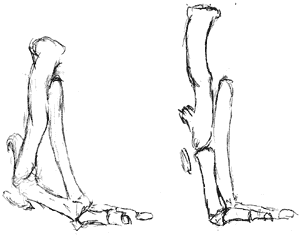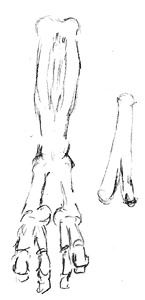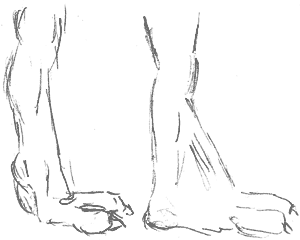 |
Introduction Site Map Email: jja@nac.net |

"I don't know. It is Odin's disk and it has only one side."
— J. L. Borges, The Disk.


Monday, July 26th, 2004
It seems that some people are using the word 'xenography' to mean writing something in a language you don't know, or writing about aliens, or writing by aliens, or suchlike. Most of these definitions, including mine, are supportable etymologically. Since the word hasn't hit the dictionaries yet (It's not in the OED, for instance), I'm going to keep using it to mean 'the illustration of alien life.'
One of the largest technical challenges I have set for myself is coming up with aliens which are convincingly realistic, in the sense that they appear solid and material, and could at least theoretically have evolved from whatever passes for protoplasmal goo in its section of the universe. A 'realistic' alien should appear to be of its world, and also of our world; in the sense that the alien's anatomy should not obviously violate physical law (unless it's a given that physical law works differently where the aliens live).
The challenge is harder because the central requirements are hard to balance: the aliens will appear as characters in a story written for humans, and must be accessible in some way by a human audience; thus they must share some characteristics with humans. However, if they have too much in common with humans, they will no longer be aliens; they'll just be people in funny suits.
To find a good balance point, I had to start with some basic assumptions.
- The planet the aliens live on is one where humans can survive with little adaption (they can at least breathe the same air and drink the same water). It's very hard to display subtle emotions with half of your characters in space suits. (You're better off making bold dramatic gestures like Neil Armstrong.)
- I decided that the aliens and humans shared some broad
similarities in evolutionary history - an upright stance, sentience
(defined as the ability to wonder whether you're really thinking or
not) and culture (capable of shunting part of their evolutionary
development into social constructs). I also assumed that the trick of 'squirting
air through your meat' to make sounds was sufficiently elementary
for them to have a spoken language. (Terry Bisson's
notorious short story, They're Made Out Of Meat, neatly punctures
standard assumptions on how aliens would view humans.)
- I assumed that certain anatomical structures would carry over, at least in spirit, just because they're good engineering / the most efficient way to accomplish something. For example, assuming the aliens have an internal skeleton, and a discrete organ for a brain, it makes sense for the brain to be surrounded by heavy plates of bone to protect it.

 Here are some planning
sketches for the foot and
ankle joint of the
most prominent aliens that will be featured in my project - the Eaie
(pronounced eee-yai-yee - their language is low on consonants). I came
to this design as follows: I saw a device for sale that lets you easily
do high jumps and somersaults; it's constructed of spring steel. I
wondered if something analogous could evolve naturally. It does
seem to confer an advantage in mobility - the question then is whether
it's biologically possible. Since my aliens live in an environment
where most available material is stronger than what we're accustomed to
finding on Earth, I decided that their bones were strong enough
to handle the stresses of such a construction.
Here are some planning
sketches for the foot and
ankle joint of the
most prominent aliens that will be featured in my project - the Eaie
(pronounced eee-yai-yee - their language is low on consonants). I came
to this design as follows: I saw a device for sale that lets you easily
do high jumps and somersaults; it's constructed of spring steel. I
wondered if something analogous could evolve naturally. It does
seem to confer an advantage in mobility - the question then is whether
it's biologically possible. Since my aliens live in an environment
where most available material is stronger than what we're accustomed to
finding on Earth, I decided that their bones were strong enough
to handle the stresses of such a construction.
To the left is how the joint might look covered in skin and muscle.
I was also intrigued by the opportunity to present what seems to be a unique sort of joint. I don't know of any skeletal joints that work on a tongue-and-groove principle; if anyone out there knows of an example, please let me know.
The design confers other advantages: the aliens can readily modify their height, more swiftly and less obtrusively than crouching - a boon in tall grass or equivalent. The small footpad is good for running fast, and the broad footpad is good when more frictive contact with the ground is required, such as pushing or dragging something.
More anon....



pageatatime.com is hosted by net access corporation - www.nac.net